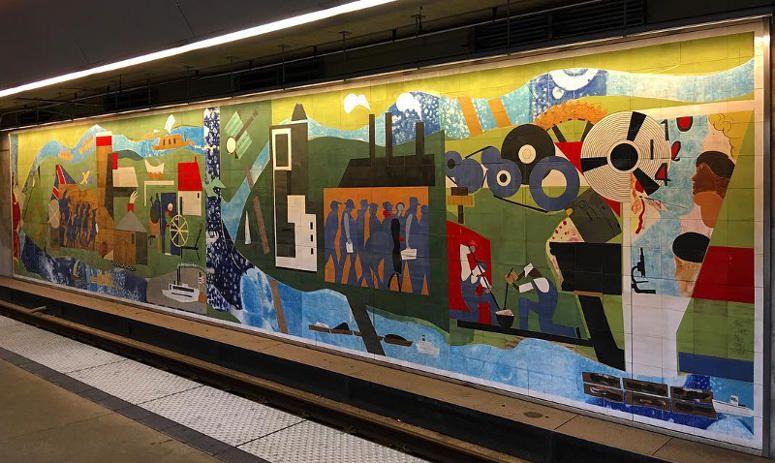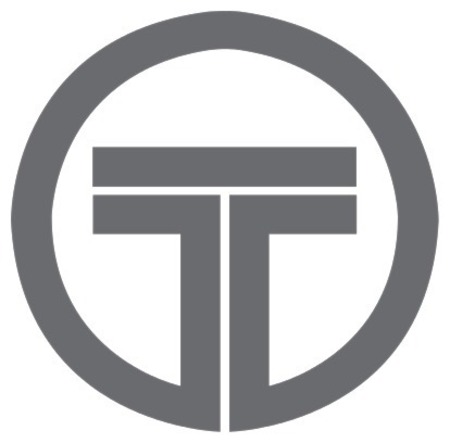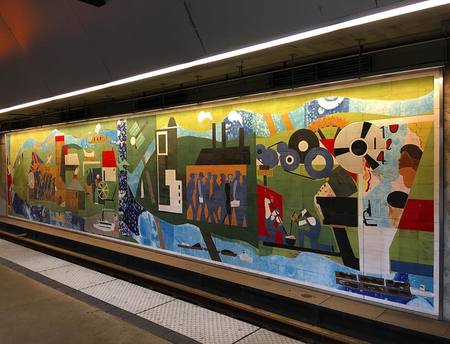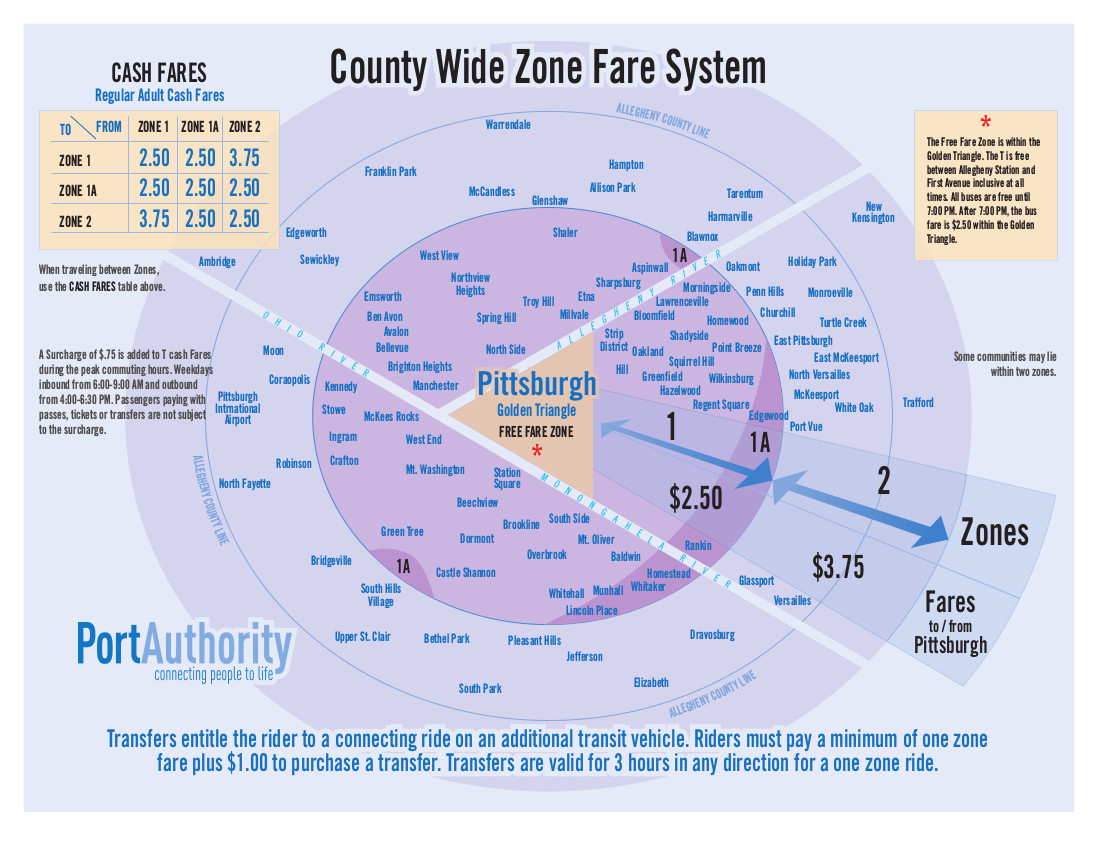Pittsburgh’s light rail also known as The T covers 42.16 kilometers (26.19 miles) between three lines and 53 stations. This mode of transport is divided in two sections. The first one is the subway, which runs underground through the city’s downtown, while the second one, the light rail runs through the southern neighborhoods.
Its official inauguration took place in 1984 after the tram system that had been operating since 1903 suffered some modifications. Since opening to the public, The T has undergone a series of additions and adaptations. With a base rate of $2.50 USD, it runs uninterrupted from approximately 5:00 a.m. until shortly after 12:00 a.m.
Subways in the United States: Pittsburgh
Located on the northeast corner of the United States of America, Pittsburgh is one of the biggest cities in the state of Pennsylvania. The city is home to the Allegheny County’s administrative center and has a territorial extension of 151.1 square kilometers (93.8 square miles) and a population of 2,356,285 in the metro area.
Pittsburgh is well known for its cultural wealth. It is home to the Pittsburgh Symphony Orchestra, one of the world’s best. In addition, the city has also played an important role in the development of important museums, such as the Carnegie Museum of Natural History and the Carnegie Museum of Art.
Weather-wise, Pittsburgh has a subtropical climate and is known for its humidity. During the winter, temperatures range from 3°C to -7°C, while reaching as high as 30°C in the summer.
The Subway
The Pittsburgh Light Rail covers 42.16 kilometers throughout the entire city and certain suburbs. It was inaugurated in 1984 when county officials decided to replace the old railway system, which had been operating since the beginning of the twentieth century.
Since opening, it has grown and evolved, becoming a system that is integrated by a subway and a light rail that compliments different routes around the city and its surroundings.
The Spanish company CAF produced its two-car bidirectional LRV trains, which were installed after the Port Authority of Allegheny County signed an agreement with the company in 2000 to renew the fleet.
The already mentioned Port Authority of Allegheny County, which is regulated by the county of Allegheny’s administration, is in charge of operating the system.
The system transports an average of 10 million passengers every year.
 Pittsburgh Metro
Pittsburgh Metro
- Known as: The T or Pittsburgh Light Rail
- Length: 42.16 kilometers
- Train track width: 1.435 mm
- Number of lines: 3
- Number of stations: 53
- Maximum speed: 72 km/h
- Website: www.portauthority.org
- Operator: Port Authority of Allegheny County
- Daily passengers: 27,000
- Year founded: 1984
Brief history
In 1903, Pittsburgh founded a railway system that ran through the city. This service was operated by Pittsburgh Railways, which was one of the most important and prestigious railway undertakings in North America. However, in 1960, the Port Authority of Allegheny County (PAT), a public company, took over and began to expanding and extending the routes.
That is how the subway route connected North Shore with the southern suburbs as well as several areas in South Hills. As the routes were extended, a new underground railway was inaugurated, one which covers the largest commuter flow in the city.
Since the state-owned company took over, the light rail also began to operate in conjunction with the bus system and the cable car that covers Allegheny County.
Not long ago, the Port Authority of Allegheny County radically changed the Pittsburgh light rail structure due to the merging of five different subway lines in order to unify them into only two lines, the red line and the blue line. In addition, the company completely modified the tariff scheme as they try to cut the losses.
Lines and stations
Pittsburgh’s subway system only has three lines that follow a north-to-south route.
Red line
This line starts at the South Hills Village station and travels all the way to Allegheny station. Most of the line operates underground with the exception of short sections, which are travel on the ground and above the ground. It covers the north-south path of the city but on the western side of Pittsburgh. A total of 32 stations make up this line, which is referred to by its color, red.
Blue line
The blue line is shorter and even though its terminal stations are also Allegheny and South Hills Village, this line goes from downtown Pittsburgh to Washington Junction, where it splits into two branches. The first one ends at South Hills Village, while the other one runs all the way to Library. With a total of nineteen stations, the blue line also travel north-to-south but on the eastern side of the city. Known by its color, the blue line.
Silver Line
The Silver Line begins in the Library neighborhood of South Park and extends to Allegheny County, to the stop with the same name. It shares many stations with the blue and red lines. It merges with the Blue Line at Washington Junction. For trips heading to downtown, the line splits again before the Overbrook Junction station on the Red Line, as the Blue Line follows the Overbrook route. The line was renamed to "Silver Line - Library" in 2020.
Connection with other transportation systems
The entire public transportation system in Pittsburgh is interconnected. The railway tracks are intertwined with bus lines, which serve the metro area and its surroundings. There is also a connection with the incline cable car system, one of the oldest services in the region. The incline cable car was built to take workers to the factories from the suburbs. Today it mainly serves as a tourist attraction.
All of the railway routes are complemented with the bus system even if some subway stations are underground, and others are on the ground or above ground. Most bus routes cover surrounding cities like Beaver, Butler and Westmoreland, while some run particularly in Pittsburgh, parallel to the light rail.
The bus system has a total of 93 different routes that transit inside Pittsburgh and 28 more assigned to different companies. Just like the railway system, the buses are also identified by the same two colors, red and blue. The red routes operate from Monday to Saturday with very limited schedules that are also off on holidays. The blue ones however, operate permanently.
Connection to the airport
The Pittsburgh International Airport is located about 30 kilometers west of the city in the suburbs of Findlay Township. This airfield is one of the most important civil and military terminals of Pennsylvania. Just like all of the transportation services in the Pittsburgh county, the airport is administrated by the Allegheny County’s Airport Security.
The airport offers 160 daily flights to 36 different destinations, which are operated by 12 airlines.
To arrive at the Pittsburgh International Airport, one must take the 28X Airport Flyer route by bus, which runs from the airport to downtown Pittsburgh stopping at every subway station on the way.

Schedules
The Pittsburgh light rail system operates all through the day and evening from around 5:00 a.m. up until 12:00 a.m. However, it varies between both the red and blue lines, which oftentimes affects the hours of operation.
On the blue line, the first train departs towards Library at 5:30 a.m., while the last one arrives at 12:10 a.m. There is an approximate time of at least twelve and a half minutes between every train during peak times in the morning and evening. However, frequency slows down ranging from 20 to 33 minutes between trains at mid-morning, early afternoon and late night.
The Allegheny and South Hills Village also serve as the red line first and last stations. However, schedules differ from the blue line. Trains start departing South Hills Village towards Allegheny at 4:54 a.m., while the last train departs at 12:01 a.m. Train departure frequency is as low as four minutes until late afternoon, approximately between 3:00 p.m. and 4:00 p.m. Throughout the rest of the day, trains depart every 12 minutes. At late night, trains depart every 30 minutes.
Fares, tickets and cards
Up until 2016, the Pittsburgh railway system had been using different tariff systems since its opening. On January 1, 2017, the Port Authority of Allegheny County made a major shift in order to try and cut losses.
Since then, fares have been substantially simplified. Even though traveling throughout downtown Pittsburgh used to be free, the company opted to reduce price zones to two and prioritize payments through the ConnectCard. In short, a single ticket inside the same price zone costs $2.75 USD, while the price increases to $3.75 USD for a zone 1 and zone 2 transfer. This is one of the highest urban tariff rates in the nation.
In addition, if the passenger needs to transfer lines, a new $2.75 USF must be paid, which is the reason light rail authority promotes the ConnectCard. With it, one can use the entire system for $2.50 USD and a $1.00 USD line transfer cost. The ConnectCard has a cost of $1.00 USD.
Reduced costs for the Pittsburgh subway system include free travel to children under six years of age and senior citizens over 65 years of age. This is not a common feature amongst public transportation systems in the United States. Also, handicapped users and Medicare health insurance holders pay $1.35 USD per ticket. With the ConnectCard, that price goes down to $1.25 per trip and $0.50 per line transfer.

System rules
Just like every public transportation system in the world, the Pittsburgh light rail has rules and regulations to guarantee passenger safety, speed up travel times, safeguard passenger well being and appropriate behavior. These rules and regulations are also set to protect and take good care of the subway facilities, as well as ensuring a correct and safe environment. Pittsburgh’s light rail rules and regulations are available online and in every station. Listed below are the main ones:
- Only service animals are allowed on the Pittsburgh light rail.
- Small pets or animals are allowed as long as the passenger is transporting them in a cage.
- It is strictly prohibited to run at any of the system’s facilities including stations and/or trains.
- It is strictly prohibited to enter or exit a train once the door closing process has begun.
- While waiting at a station, it is strictly prohibited to cross the safety yellow line.
- If traveling with children, it is mandatory to hold hands and/or keep them close to the adult passenger.
- In case of traveling with baby strollers, it is important to remain on specially designed areas in order to avoid obstructing transit.
- All transit inside the system’s facilities must be done on the right side of the road or hall.
- An appropriate behavior and civilized conduct is mandatory inside the light rail facilities.
- Food and drinks are extremely prohibited inside the light rail facilities.
- Obstructing and leaning on train doors is strictly prohibited.
- Designated sits may only be used by pregnant women or senior citizens.
- Carrying firearms is strictly prohibited.
- Emergency and fire alarms should only be used in case of emergency. On the contrary, the passenger will be penalized.
Future Expansion
The Port Authority of Allegheny County has been working on developing a plan to improve transportation throughout the last decade. This has resulted in many changes to the railway system. From that restructuring idea, some extension projects are still pending and will be taking effect in the coming years. These consist on building new railways that will connect Pittsburgh with neighboring cities or extending the already existing ones.
Some that are already undergoing construction are a light rail main route will end at the Oakland neighborhood. There are also plans on building a new rail network that will inter-connect with the current lines running from downtown Pittsburgh to Arnold and the Allegheny Valley Railroad. There have also been talks about a new line that will go from downtown to Greensburg.
Parking
Among the public transportation services that the Port Authority of Allegheny County offers are the more than 60 parking lots that are distributed throughout the city. Most of them are located near every station and bus routes. They are free of charge as long as light rail or bus passengers are using them. There are a total of 14,000 spots, which represents a great transportation alternative for Pittsburgh residents.
 Gateway Subway Station
Gateway Subway Station
Tips
- In order to avoid any confusion in relation to fares, it is recommended to check price areas corresponding the passengers route and/or line transfers. This will prevent unforeseen costs.
- Following the adjustments made by the Port Authority of Allegheny County, many lines and branches are no longer in operation. However, there are still outdated maps, which means it is important to review the updated and correct information on the official state website.
- Even though the Pittsburgh light rail is known for being a safe transportation system, it is highly encouraged to keep belongings on the front side of your body or to stay near them to prevent possible theft.
- While the Pittsburgh light rail does not rank amongst the biggest in the United States, it serves a major number of passengers every day, which can result in crowded or full trains. It is recommended to avoid its usage to convalescing people or passengers with newborns.
- Before traveling, it is recommended to get information regarding peak hours and train arrival times during those hours. This information can avoid delays.
- Since the light rail is a transportation system with large inflows, it is important to make room for other passengers inside the train.
- Once inside the train, it is important to locate safety handles or rails as well as route maps to ensure a safe and precise trip.
Fun facts
- While the light rail system provides parking lots to its users, passengers are allowed to travel with their bicycles for free.
- Throughout the last decade, the Pittsburgh light rail has removed at least five subway lines and more than a dozen stations as part of a system development plan.
- The Pittsburgh railway does not have air conditioning inside its trains.
What to see from the Pittsburg light rail
This metropolis located in the state of Pennsylvania has always been known for being an industrial city and for the vast amount of modern structure and architecture. However, Pittsburgh also stands out for a number of other reasons. The city has invested a lot in spaces designed to promote culture like its art and science museums as well as theaters. In addition, there are a significant amount of garden areas and pedestrian streets for leisure and entertainment. Listed below are some of the main landmarks and most visited spots:
- Phipps Conservatory and Botanical Gardens: this beautiful botanical garden, founded in 1893, is located inside Schenley Park, a historic place featuring modern buildings and nature walks and gardens. Besides being home to hundreds of plant species, it is also known for its sophisticated architecture, which is mostly made of glass and metal. To get there, one must take the light rail blue line to Frew followed by a short walk.
- Andy Warhol Museum: Andy Warhol is one of the most renowned artists dedicated to pop culture. The museum was founded in 1994 and named a World Heritage Site in 2000. Since opening, more than 150,000 people have visited it. To get there, one must take the light rail red line to North Side followed by a short walk.
- Carnegie Science Center: this is one of the Carnegie museums in Pittsburgh. The Science Center is one of the most visited entertainment centers in the state of Pennsylvania. It is made up of four stories with different attractions like a planetary, multiple simulators, a robot exhibit and more. To get there, one must take the light rail’s blue or red line to the Allegheny station and a short walk north.
Metro map of Pittsburgh
Map via www.rideprt.orgSee map full resolution. It may take a little bit to load.
Download map.
Pittsburgh The T map
- Also Known As: The T
- Passengers/Day 27000
- Fares:
- 24h operation: No
- Air Conditioning: No
- Walk between platforms: No
- Driverless trains: No
- Screen Doors Platforms: No
- $2
- Pittsburgh Metro Official Website
Help us
If you consider that the information we provide is wrong, not accurated, outdated, translation contains errors, and you would like to help us to improve the file...you can contact us here.
Feel free to contact us if you dont find the system you're looking for and we'll add it as soon as we can!
Thank you very much!











